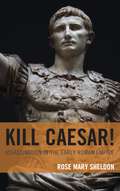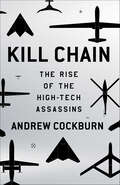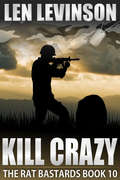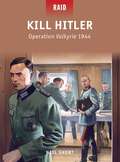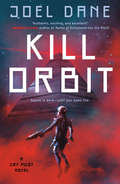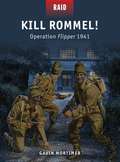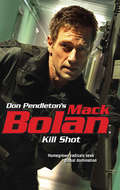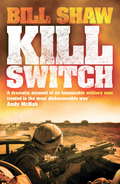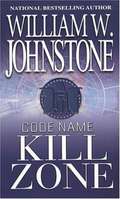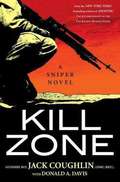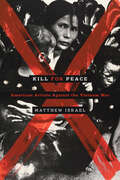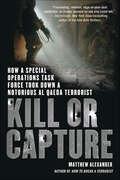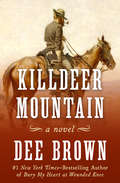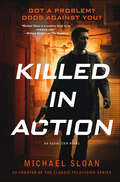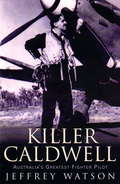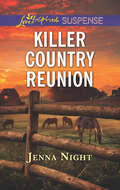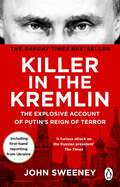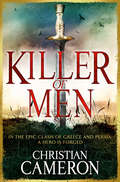- Table View
- List View
Kill Caesar!: Assassination in the Early Roman Empire
by Rose Mary Sheldon&“Why were Rome&’s first emperors—the good, the bad, and the ugly—so vulnerable to conspiracies and assassination? . . . an expert analysis . . . compelling.&” —Adrienne Mayor, author of The Poison King: The Life and Legend of Mithradates and Rome&’s Deadliest Enemy Exploring the history of internal security under the first Roman dynasty, this groundbreaking book answers the enduring question: If there were 9,000 men guarding the emperor, how were three-quarters of Rome&’s leaders assassinated? Rose Mary Sheldon traces the evolution of internal security mechanisms under the Julio-Claudians, evaluating the system that Augustus first developed to protect the imperial family and the stability of his dynasty. Yet in spite of the intensive precautions taken, there were multiple attempts on his life. Like all emperors, Augustus had a number of competing constituencies—the senate, the army, his extended family, the provincials, and the populace of Rome—but were they all equally threatening? Indeed, the biggest threat would come from those closest to the emperor—his family and the aristocracy. Even Roman imperial women were deeply involved in instigating regime change. By the fourth emperor, Caligula, the Praetorian Guards were already participating in assassinations, and the army too was becoming more politicized. Sheldon weighs the accuracy of ancient sources: Does the image of the emperor presented to us represent reality or what the people who killed him wanted us to think? Were Caligula and Nero really crazy, or did senatorial historians portray them that way to justify their murder? Was Claudius really the fool found drooling behind a curtain and made emperor, or was he in on the plot from the beginning? These and other fascinating questions are answered as Sheldon concludes that the repeated problem of &“killing Caesar&” reflected the empire&’s larger dynamics and turmoil.
Kill Chain: The Rise of the High-Tech Assassins
by Andrew CockburnAn essential and page-turning narrative on the history of drone warfare from journalist Andrew Cockburn, exploring how this practice emerged, who made it happen, and the real consequences of targeted killing.Assassination by drone is a subject of deep and enduring fascination. Yet few understand how and why this has become our principal way of waging war. Kill Chain uncovers the real and extraordinary story; its origins in long-buried secret programs, the breakthroughs that made UAV operations possible, the ways in which the technology works and, despite official claims, does not work. Taking the reader inside the well-guarded world of national security, the book reveals the powerful interests - military, CIA and corporate - that have led the drive to kill individuals by remote control. Most importantly of all, the book describes what has really happened when the theories underpinning the strategy -- and the multi-billion dollar contracts they spawn -- have been put to the test. Drawing on sources deep in the military and intelligence establishments, Andrew Cockburn's Kill Chain unveils the true effects, as demonstrated by bloody experience, of assassination warfare, a revelation that readers will find surprising as well as shocking.
Kill Crazy: Kill Crazy (The Rat Bastards Series #10)
by Len LevinsonThe joy of killing. The enemy's plotting against them-while they're tearing at each other's throats! Malaria could lay them on their backs. Jungle fever threatens to strip their sanity. An army of death marches through bloody war zones looking to tear their guts out. But over the roar of grenades and the swish of Samurai swords you can always hear the spine-curdling battle cry of the guys who kill their way to victory...The Rat Bastards.
Kill Hitler - Operation Valkyrie 1944
by Peter Dennis Neil ShortAt the end of 1943 the SS and the Gestapo arrested several prominent Germans involved in plotting to overthrow Adolf Hitler, including Dietrich Bonhoffer, Klaus Bonhoffer, Josef Muller and Hans Dohnanyi. Others under suspicion, such as Wilhelm Canaris and Hans Oster, were dismissed from office in January 1944. Major Claus von Stauffenberg emerged as a leader of the group of German Army officers opposed to Nazi rule, and began to plan for the assassination of Adolf Hitler, Hermann Goering and Heinrich Himmler, and for a takeover by the Army. Once these three prominent Nazis had been killed, the plan called for troops in Berlin and other major German-controlled areas, commanded by his co-conspirators, to seize key government buildings, telephone and signal centres and radio stations. At least six attempts were aborted before von Stauffenberg decided on trying again during a conference attended by Hitler on 20 July 1944. It was decided to abandon the plans to kill Goering and Himmler at the same time, and to focus solely on removing the Führer. Von Stauffenberg carried the bomb in a briefcase and placed it on the floor beside Hitler before excusing himself to make a phone call. The bomb exploded killing four men in the hut. Hitler was injured but survived the bomb blast. The plan that called for Ludwig Beck, Erwin von Witzleben and Erich Fromm to take control of the German Army and declare martial law was abandoned when it became known that Hitler had survived the assassination attempt. In an attempt to protect himself, Fromm organized the execution of Claus von Stauffenberg and two other conspirators, Friedrich Olbricht and Werner von Haeften, in the courtyard of the War Ministry. It was later reported that von Stauffenberg died shouting "Long live free Germany". As a result of the 20 July Plot, the new chief of staff, Heinz Guderian, demanded the resignation of any officer who did not fully support the ideals of the Nazi Party and presided over the Army Court of Honour that expelled hundreds of officers suspected of being opposed to the policies of Adolf Hitler. This removed them from military jurisdiction and left them to be sentenced by Roland Freisler and his fanatically pro-Nazi People's Court. Over the next few months most of the group including Wilhelm Canaris, Carl Goerdeler, Julius Leber, Ulrich Hassell, Hans Oster, Peter von Wartenburg, Henning von Tresckow, Ludwig Beck, Erwin von Witzleben and Erich Fromm were either executed or committed suicide. It is estimated that nearly 5,000 Germans were executed as a result of the events of the July Plot. Hitler ordered that the leaders should have a slow death. They were hung from meathooks with piano wire, and their executions were filmed and later shown to senior members of both the NSDAP and the armed forces.
Kill Orbit (Cry Pilot #3)
by Joel DaneA hostile fleet. A planet killer. And one shot to make it right.In this gripping new military science-fiction novel, a battle-tested infantry squad pursues an inhuman enemy into the vacuum of space.Maseo Kaytu's squad is yanked from a much-deserved furlough by an emergency deployment off-planet. But why is Command sending grunts into the "Big Empty"? Without CAVs, without backup--hell, without gravity--the squad is more vulnerable than ever. Tasked with a mission that only they can complete, they track the enemy across the killing vastness of space, from a bizarre interplanetary warehouse to the hidden heart of a research habitation...and beyond. But the enemy is tracking them, too. Scanning, calculating, preparing. Kaytu joined the military to redeem the bad choices of his past, yet now--trapped in hostile territory--he learns that soldiers face the hardest choices of all.
Kill Rommel! - Operation Flipper 1941
by Gavin Mortimer Peter DennisBritish Commandos attempted to assassinate Rommel, the Desert Fox, in a daring special forces raid in North Africa during World War II.On the night of 13 November 1941 two British submarines surfaced off the Libyan coast 250 miles behind German lines. It was dark and stormy, and the 28 commandos on board Torbay had great difficulty climbing into their rubber dinghies and paddling towards the shore. Disaster struck the second submarine, Talisman, when a giant wave swept eleven commandos waiting on deck overboard. At dawn on the morning of 13 November the depleted raiding party was finally ashore, cold, wet and exhausted, but determined nonetheless to press on with their audacious mission - the assassination of General Erwin Rommel, commander of the German forces in North Africa. The raid made headlines round the free world. It was a shining example of British pluck and daring, proclaimed the papers, and to prove the point, Keyes was awarded a posthumous Victoria Cross. Yet in truth the raid had been a glorious failure, a mission bedevilled by bad planning and poor intelligence. Yet crucial lessons were learned by subsequent special forces' operations, particularly by the SAS who carried out their first mission on the same night as the raid on Rommel's HQ. By the end of World War II the British special forces were the best in the world.
Kill Shot
by Don PendletonThe terror begins with ruthless precision when the clock strikes noon, gunfire ringing out in major cities along the east coast. As blood spills across the country, Bolan sets his crosshairs on their nightmare agenda.
Kill Switch
by Bill ShawFrom surviving a horrific terrorist attack in Northern Ireland, to the violence of the Gulf War and an assault course of harrowing experiences in Iraq, Bosnia and Columbia, Major Bill Shaw had seen it all. But Bill's strength and courage was tested to its absolute limits when he was arrested for a crime he did not commit. Posted in Afghanistan after two years in Iraq, Bill was responsible for the safety of four hundred men in a full-scale danger zone in one of the most dangerous countries in the world. The married father and grandfather, who had risen through the ranks to become a commander of men and an MBE, had long accepted that each day could be his last. But he never expected to find his own life at risk under a corrupt legal system. Thrown into prison and forced to share a cramped, vermin-infested cell with sixteen Afghans, among them members of the Taliban and al-Qaeda, Bill had no idea when, or even if, he would see his family again. This is the incredible true story of a brave soldier who survived some of the toughest war zones in the world only to face the nightmare of being wrongfully imprisoned a very long way from home. Gritty and gripping, this powerful military memoir is an eye-opening account of life on the frontline.
Kill Switch (A\jed Walker Series Novel Ser. #3)
by James PhelanThe countdown has begun ... The world is under cyber attack. The secretive terror outfit of linked lone-wolf operatives, known as Zodiac, has activated another terrorist cell. Chaos will be unleashed at six-hour intervals, with each event more catastrophic than the last, culminating in a devastating global catastrophe within 48 hours. The options for the hackers are endless: bring down California's telecom system; remote detonate explosives at an army base in Virginia; cause Amtrak's signals to fail; collapse air traffic control in US airspace. Consequences are unthinkable. The US President has the power to enact the Internet Freedom Act - the 'Kill Switch'. Turning off the Net will stop the attacks, and give the CIA and the Pentagon time to track down those responsible. But it's not that simple. Fourteen people with the key to restart the Internet are missing. The US will plummet into pandemonium if electronic communications cease. The rest of the world will follow. Jed Walker, ex CIA-operative, has thwarted Zodiac twice before. But, this time, nothing will prepare him for what he uncovers. Walker has 48 hours, and the countdown has begun ...
Kill Without Mercy (Ares Security #1)
by Alexandra IvyA Texas covert ops specialist hunts down a serial killer in this romantic suspense series opener by the New York Times–bestselling author of Don&’t Look. From the hellhole of a Taliban prison to sweet freedom, five brave military heroes have made it home—and they&’re ready to take on the civilian missions no one else can. Individually they&’re intimidating. Together they&’re invincible. They&’re the men of ARES Security. Rafe Vargas is only in Newton, Iowa, to clear out his late grandfather&’s small house. As the covert ops specialist for ARES Security, he&’s eager to get back to his new life in Texas. But when he crosses paths with Annie White, a haunted beauty with skeletons in her closet, he can&’t just walk away—not when she&’s clearly in danger . . . There&’s a mysterious serial killer on the loose with a link to Annie&’s dark past. And the closer he gets, the deeper Rafe&’s instinct to protect kicks in. But even with his considerable skill, Annie&’s courage, and his ARES buddies behind him, the slaying won&’t stop. Now it&’s only a matter of time before Annie&’s next—unless they can unravel a history of deadly lies that won&’t be buried.Praise for Kill Without Mercy &“A fantastic blend of romance and suspense . . . thrilling to the end.&” —Mary Burton, USA Today–bestselling author &“Prolific Ivy . . . introduces an intimidatingly hot set of protagonists for her new contemporary romantic thriller series.&” —Publishers Weekly &“If you want an action packed, steamy and hard-hitting mystery with a number of unexpected twists, then pick up Kill Without Mercy and you will not be disappointed.&” —Fresh Fiction
Kill Without Shame (Ares Security #2)
by Alexandra IvyA murder mystery reunites a veteran with an embittered ex in this romantic suspense novel by the New York Times–bestselling author of Kill Without Mercy. Five brave military heroes have survived the hell of a Taliban prison to return home—and take on civilian missions no one else can. They&’re the men of ARES Security. Highly skilled, intimidating, invincible, and one by one, tested again and again . . . Lucas St. Clair&’s prestigious family had a political future planned out for him—one that didn&’t include his high school sweetheart, Mia Ramon. Under their pressure, Lucas gave her up. But since surviving captivity, he&’s a changed man—and a crucial member of ARES Security. When he discovers a dead man clutching a picture of Mia that bears a threatening message, his fiercest protective instincts kick in, and he knows he must go to her. Mia has never forgiven Lucas for breaking her heart, and she&’s convinced her feelings for him are in the past. But it&’s soon clear that isn&’t true for either of them. Now, determined to solve the crime and keep Mia safe, with his ARES buddies backing him up, Lucas will have to reconstruct the murder victim&’s last days—and follow a lethal trail that leads right back to the fate of the woman he still loves . . .Praise for Kill Without Mercy &“A fantastic blend of romance and suspense . . . thrilling to the end.&” —Mary Burton, USA Today–bestselling author &“If you want an action packed, steamy and hard-hitting mystery with a number of unexpected twists, then pick up Kill Without Mercy and you will not be disappointed.&” —Fresh Fiction
Kill Zone (Code Name Series #7)
by William W. JohnstoneThe world is stunned when a cocaine king begins his own country built on drugs, misery, and blood. Barrone and his team are to pay a visit to this new country and take out the drug king.
Kill Zone (Sniper Series #1)
by Jack Coughlin Donald A. DavisAn American general is captured in the Middle East by terrorists who threaten to behead him within days. One strange fact: moments before he is rendered unconscious during the attack, the general notices that his captors speak American English. What's going on? Gunnery Sgt. Kyle Swanson, a top Marine sniper, is vacationing on a yacht in the Mediterranean when he receives orders to mount a top secret mission to rescue the general. But as the Marines prepare to land in the Syrian desert, they fall victim to a terrible accident. Swanson, the only survivor, then discovers they were also flying into an ambush. How did the enemy have details of a mission known only to a few top American government officials? Swanson takes off across the desert alone to find the captured general and realizes he is fighting a particularly ruthless and dangerous enemy: American mercenaries working for a very-high-level group of U.S. officials with ties to the White House itself, part of a clandestine conspiracy whose hidden goal is nothing less than total control of the American military. Their sworn enemy is the captured general whose fate now rests in Swanson's hands. Filled with the kind of action that author Jack Coughlin lived during his career as a Marine sniper, Kill Zone marks the debut of an extraordinary new series.
Kill Zone: Romantic Suspense (Danger in Arms #2)
by Cindy Dees"Lovers of Dees’ high-stakes, fast-paced action will find exponentially increasing tension in each scene and pulse-pounding adventure that will keep readers enthralled." ~Romantic Times Book ReviewsAmanda McClintock is a stone-cold killer on the edge with no capacity for love. Tasked with tracking the source of artificial diamonds so good they threaten to collapse the world diamond market, she's assigned a babysitter to see her through one last mission.Taylor Roberts is an intelligent, idealistic psychologist with a mission of his own…keep Amanda in the game.But when Amanda falls to her humanity, it's Taylor who must assume responsibility for keeping them alive. As their roles reverse, so do their hearts as they struggle together for survival.Publisher's Note: For readers who enjoy stories with strong women, hot romance, thrilling adventure, and spine-tingling suspense. Don't miss the other books in the Danger in Arms series."Dees blends action and intrigue with deft skill, keeping readers enthralled until the final secret is unveiled and the last chase winds down." ~RT Book Reviews on Close Pursuit"Finally! Women with a killer instinct for self-preservation…highly, hotly, recommended!" ~M Hartsell, on Kill ZoneThe Women in Arms SeriesFever ZoneKill ZoneHot Zone
Kill for Peace: American Artists Against the Vietnam War
by Matthew Israel&“The book addresses chronologically the most striking reactions of the art world to the rise of military engagement in Vietnam then in Cambodia.&” —Guillaume LeBot, Critique d&’art The Vietnam War (1964–1975) divided American society like no other war of the twentieth century, and some of the most memorable American art and art-related activism of the last fifty years protested U.S. involvement. At a time when Pop Art, Minimalism, and Conceptual Art dominated the American art world, individual artists and art collectives played a significant role in antiwar protest and inspired subsequent generations of artists. This significant story of engagement, which has never been covered in a book-length survey before, is the subject of Kill for Peace. Writing for both general and academic audiences, Matthew Israel recounts the major moments in the Vietnam War and the antiwar movement and describes artists&’ individual and collective responses to them. He discusses major artists such as Leon Golub, Edward Kienholz, Martha Rosler, Peter Saul, Nancy Spero, and Robert Morris; artists&’ groups including the Art Workers&’ Coalition (AWC) and the Artists Protest Committee (APC); and iconic works of collective protest art such as AWC&’s Q. And Babies? A. And Babies and APC&’s The Artists Tower of Protest. Israel also formulates a typology of antiwar engagement, identifying and naming artists&’ approaches to protest. These approaches range from extra-aesthetic actions—advertisements, strikes, walk-outs, and petitions without a visual aspect—to advance memorials, which were war memorials purposefully created before the war&’s end that criticized both the war and the form and content of traditional war memorials. &“Accessible and informative.&” —Art Libraries Society of North America
Kill or Capture: How a Special Operations Task Force Took Down a Notorious al Qaeda Terrorist
by Matthew AlexanderThe electrifying true story of the pursuit for the man behind al Qaeda's suicide bombing campaign in Iraq Kill or Capture is a true-life thriller that tells the story of senior military interrogator Matthew Alexander's adrenaline-filled, "outside the wire" pursuit of a notorious Syrian mass murderer named Zafar—the leader of al Qaeda in northern Iraq—a killer with the blood of thousands of innocents on his hands. In a breathless thirty-day period, Alexander and a small Special Operations task force brave the hazards of the Iraqi insurgency to conduct dangerous kill-or-capture missions and hunt down a murderer. Kill or Capture immerses readers in the dangerous world of battlefield interrogations as the author and his team climb the ladder of al Qaeda leadership in a series of raids, braving roadside bombs, near death by electrocution and circles within circles of lies.
Killdeer Mountain: A Novel
by Dee BrownAn intrepid reporter&’s investigation into the death of a controversial major reveals a surprising story of betrayal and redemptionIt is 1866, and Sam Morrison, reporter for the St. Louis Herald, is aboard a steamer bound for Fort Standish off the coast of Massachusetts, determined to solve a mystery. The fort is about to be renamed in honor of Charles Rawley, a major who recently died in a fire while trying to prevent the escape of a captured Sioux chief. But just who was Rawley? Morrison is told a dizzying host of tales about the man—some call him a despot but others describe him as a martyr. He was a man all too willing to execute a deserter, but one who would spur his troops to do the utmost to ensure the safety of women and children. As the investigation unfolds, Morrison doesn&’t know which stories to believe—especially when it comes to the truth about Rawley&’s death. Thrilling and wily, Killdeer Mountain is a deft triumph of historical fiction. This ebook features an illustrated biography of Dee Brown including rare photos from the author&’s personal collection.
Killed in Action: An Equalizer Novel (The Equalizer)
by Michael SloanAn ex-CIA agent travels to Syria in search of a missing US Army captain in this thriller by the co-creator of the classic TV show The Equalizer.Michael Sloan, the co-creator of The Equalizer—the classic TV show now reimagined in a series starring Queen Latifah—presents an original story of the mysterious ex-intelligence operative using his skills to help people in desperate and dangerous situations . . .“Got a problem? Odds against you? Call the Equalizer.”Robert McCall, also known as “The Equalizer,” is living a dual life, pushing himself beyond his limits to save lives.Just as McCall tests the bounds of his resilience, an intriguing proposition comes from a United Nations diplomat. Her son, a dedicated American Army Captain, has disappeared in the perilous backdrop of the Syrian war. With no confirmation of his death, she seeks McCall’s efficient assistance in unveiling the truth.McCall’s mission deep in the Syrian war zone takes an unexpected turn when he stumbles upon a spine-chilling terror plan targeted at the United States. Bound by loyalty and driven by courage, McCall’s journey is an edge-of-your-seat experience.
Killer Caldwell: Australia's Greatest Figher Pilot
by Jeffrey WatsonClive 'Killer' Caldwell was a natural and brilliant pilot, a superb shot, and a born leader. He saw action against the Germans, Italians and Japanese, and remains Australia's greatest ever fighter pilot.Born and brought up in Sydney, it was obvious from an early age that nothing would stand in Caldwell's way. He bluffed his way into the RAAF, then made sure that he was posted to exactly where he thought he should be.His ability was unquestioned by all those around him, and he devised the vital 'shadow shooting' technique which contributed so much to Allied success in the air in the north African campaign, and in northern Australia. But he was never afraid of voicing his opinions to all those above and below him, be it about the training of pilots, or the equipping of Spitfires for use against the Japanese - and for trying to run the show his way...Caldwell ended his military career in the Morotai Mutiny in 1945, where he and a number of other Australian pilots tried to resign their commisions in protest at not being allowed by General MacArthur - and the RAAF - to take part in the main action. And then he was embroiled in the Barry inquiry into booze smuggling by him and other pilots...Killer Caldwell is a colourful portrait of a colourful Australian.
Killer Country Reunion: Vanished In The Night Fatal Recall Killer Country Reunion
by Jenna NightA woman must look to her ex-fiancé to protect herself and her family in this inspirational romantic suspense novel.After gunmen attack Caroline Marsh, she’s stunned that she survives—and shocked that her rescuer is her ex-fiancé, Zane Coleman. With her family’s safety on the line, there’s no time for grudges over the past. The killers on her trail won’t give up easily. And although Zane already left her once, for her own protection, he’s not about to lose Caroline again.
Killer Elite
by Robert RostandMike Locken, a former specialist in security and transport, takes on a job to shepherd an exiled African politician in a risky transit across London, the first step in a triumphant return to his homeland. But out there somewhere waits an elite team of international assassins contracted to take him down -- one of whom not so long ago put three bullets into Locken that should have left him a corpse, but didn't... one bad guy's big mistake.
Killer Secrets (National Forest K-9 #3)
by Kathleen DonnellyA small town&’s deadly past is exposed in the newest installment of the suspenseful National Forest K-9 series by Kathleen Donnelly. Until an avalanche ripped down a mountainside, exposing a serial killer&’s dumping grounds, Antler Valley, Colorado, was a quiet town. Now Forest Service officer Maya Thompson and her beautiful K-9, Juniper, must catch the murderer before they become the next targets. With the neighboring town&’s new overconfident sheriff deterring the entire investigation, a murderer on the loose and heartthrob deputy Josh Colton racing through her mind, Maya is at a crossroads. Josh is ready to go all in, but Maya has one foot out the door. As she lets her guard down, she needs to accept that she&’s falling deeply in love with him, no matter how risky it may be. When evidence from the Antler Valley victims links the murders to deaths in other ski towns, secrets long buried are unearthed. Maya and Juniper must run toward an answer, though finding it might lead them directly into a fatal trap…National Forest K-9Book 1: Chasing JusticeBook 2: Hunting the TruthBook 3: Killer Secrets
Killer in the Kremlin: The instant bestseller - a gripping and explosive account of Vladimir Putin's tyranny
by John SweeneyTHE INSTANT SUNDAY TIMES BESTSELLER - NOW UPDATED WITH FOUR NEW CHAPTERS'This swashbuckling book is a furious attack on the Russian president. Killer in the Kremlin traces Putin's bloody career... a life littered with corpses.' - THE TIMESA gripping and explosive account of Vladimir Putin's tyranny, charting his rise from spy to tsar, exposing the events that led to his invasion of Ukraine and his assault on Europe.In Killer in the Kremlin, award-winning journalist John Sweeney takes readers from the heart of Putin's Russia to the killing fields of Chechnya, to the embattled cities of an invaded Ukraine.In a disturbing exposé of Putin's sinister ambition, Sweeney draws on thirty years of his own reporting - from the Moscow apartment bombings to the atrocities committed by the Russian Army in Chechnya, to the annexation of Crimea and a confrontation with Putin over the shooting down of flight MH17 - to understand the true extent of Putin's long war.Drawing on eyewitness accounts and compelling testimony from those who have suffered at Putin's hand, we see the heroism of the Russian opposition, the bravery of the Ukrainian resistance, and the brutality with which the Kremlin responds to such acts of defiance, assassinating or locking away its critics, and stopping at nothing to achieve its imperialist aims.In the midst of one of the darkest acts of aggression in modern history - Russia's invasion of Ukraine - this book shines a light on Putin's rule and poses urgent questions about how the world must respond.'An extraordinarily prescient and fascinating book.' - NIHAL ARTHANAYAKEInstant Sunday Times bestseller, March 2023
Killer of Men
by Christian CameronIn the epic clash of Greece and Persia, a hero is forged - a monumental novel from the author of the Tyrant series.Arimnestos is a farm boy when war breaks out between the citizens of his native Plataea and their overbearing neighbours, Thebes. Standing in the battle line for the first time, alongside his father and brother, he shares in a famous and unlikely victory. But after being knocked unconscious in the melee, he awakes not a hero, but a slave.Betrayed by his jealous and cowardly cousin, the freedom he fought for has now vanished, and he becomes the property of a rich citizen. So begins an epic journey out of slavery that takes the young Arimnestos through a world poised on the brink of an epic confrontation, as the emerging civilization of the Greeks starts to flex its muscles against the established empire of the Persians. As he tries to make his fortune and revenge himself on the man who disinherited him, Arimnestos discovers that he has a talent that pays well in this new, violent world - for like his hero, Achilles, he is 'a killer of men'.
Killer of Men (The Long War)
by Christian CameronIn the epic clash of Greece and Persia, a hero is forged - a monumental novel from the author of the Tyrant series.Arimnestos is a farm boy when war breaks out between the citizens of his native Plataea and their overbearing neighbours, Thebes. Standing in the battle line for the first time, alongside his father and brother, he shares in a famous and unlikely victory. But after being knocked unconscious in the melee, he awakes not a hero, but a slave.Betrayed by his jealous and cowardly cousin, the freedom he fought for has now vanished, and he becomes the property of a rich citizen. So begins an epic journey out of slavery that takes the young Arimnestos through a world poised on the brink of an epic confrontation, as the emerging civilization of the Greeks starts to flex its muscles against the established empire of the Persians. As he tries to make his fortune and revenge himself on the man who disinherited him, Arimnestos discovers that he has a talent that pays well in this new, violent world - for like his hero, Achilles, he is 'a killer of men'.
